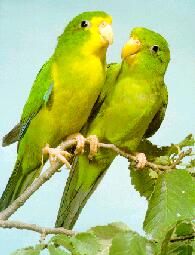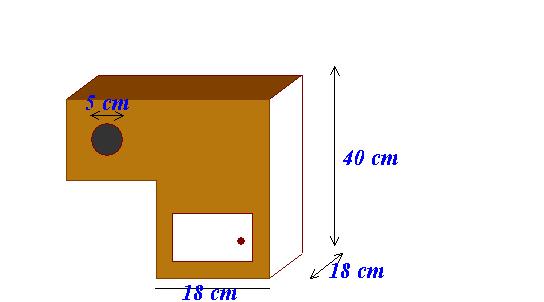PARAKEET OF MOUNTAINS

Italian: Parakeet of mountains
English: Mountain Parakeet
German: Zitronensittich
Unfortunately this beautifulst representative of the sort Bolborynchus remains a little diffused known parakeet little and in Italy; the riproduttrici braces in hung ours are available senz' other on the fingers of one hand.
Held account that not sure a sturdy and easy stressabile subject needs of adequate cures and not advisable to the principianti.
The sexual dimorfismo, for against, the much marked in how much solo male extension the mask and the yellow chest lemon and the blue of the wings devout intense that in the female.
Length: 18-20 centimeters (thanks in the long run tail)
Distribution: for
Natural diet: seeds, gems of trees, yield, berries and material vegetable.
Breeding in nature: the period of breeding begins after the season of rains, from October until the December end.
Feeding: mixture of seeds for small parakeets with least small sunflower and much scagliola; much fruit and verdure (carrot, pear, apple, maize, etc.) and, in the riproduttivo period, seeds germinate to you; pastoncino proteico for the breeding of iccoli.Personalmente I put to disposition of the riproduttori a animal food made in added seed house bubbled and frutta.Osso of small cuttlefish (or notebooks of know them mineral), grit and fresh water always to disposition.
Breeding in cattivit: As gi I have said the riproduttrici braces in Italy are a lot little and in Europe not that the things go very better.
Personally son in possession of a brace of 3 years of ET that just this year has placed pearl before time 6 eggs.
I have lodges them to you in a gabion of 150 x 50 x 40 supplied of branches of salice that create in an angle a small natural habitat and that the soggeti they are amused to rosicchiare.
The character of these parakeets particular. Also being timid and recognizing in little time the breeder, they are not many stressabili and they do not have to be subordinates, if for extreme necessit to bruschi changes it does not acclimatize them. Not rare that a soggeto it dies during the transposed one and not sure the ideal species for preferred who in the extensions.
Their little fastiodioso back and, indeed, pu to even turn out melodioso.
They resist to minimal temperatures of 10C, if they have the possibilit to shelter itself in a nest very coibentato but they live better in atmospheres leggermente heats to you during the winter.
The main reproduction begins in winter and therefore the breeding atmospheres must very be illuminate in order at least 14 hours to you to the day.
They place from 4 to 6 eggs, intervals tdi 24 hours and begin to incubate from according to egg.
Incubation 24 days; the small are nourished in the nest, from the female imbeccata from the male, for four - six weeks and the young people that exit from the nest are normally independent after one week - ten days from the involo.
Nest: 
In reproduced figure a cassette nest that personally I use. The planning laughed them to some has ago to work of a Dutch. The nest tries to reproduce the conditions in which in nature the aurifrons are reproduced.
They, in fact have the habit to dig, in the termitai, long tunnels (also 2,5 meters!) until to one small room nest. In this way they avoid that the changes of temperature between day and night, typical of the Andes, provoke the dead women of the small.
I have not never tried to use traditional devout nests but of it I do not exclude the possible one I use.
BOLBORYNCHUS AURIFRONS ROBERTSI

Difficult to recognize from the nominal species in how much the only difference that in the male the yellow less extensive and defined and the generally devout tone of dark green.
BOLBORYNCHUS AURIFRONS RUBRIROSTRIS

Much similar to the nominal species but in both seies nonvi trace of giallo.La female acknowledges from the male for the dark piumaggio devout and the grey advanced jaw.
SUGGESTED BREEDINGS by MENANDPETS.COM
No breeding to signal
if you want to know like signaling yours, contacts: marketing@inseparabile.it
BOLBORYNCHUS AURIFRONS MARGARITAE

Much similar one to the species rubrirostris from which it differs essentially for the dark piumaggio devout and without giallo.La female acknowledges from the male for the dark piumaggio devout and the grey advanced jaw.
we thank the breeding agate in order to have to us supplied this card